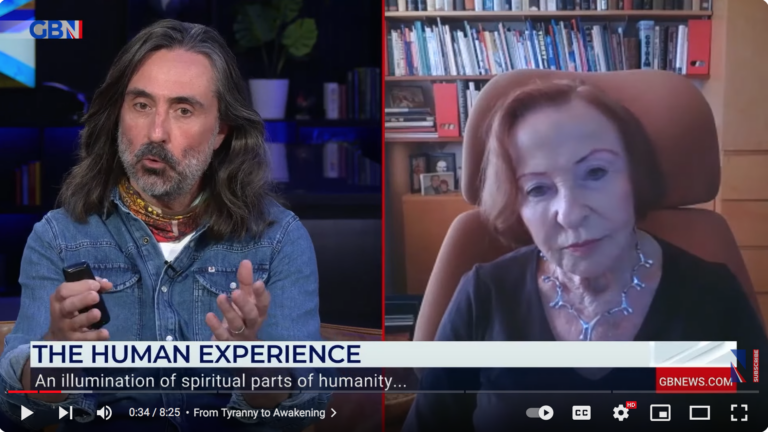Weapons of mass deception: false claims, corrupted science
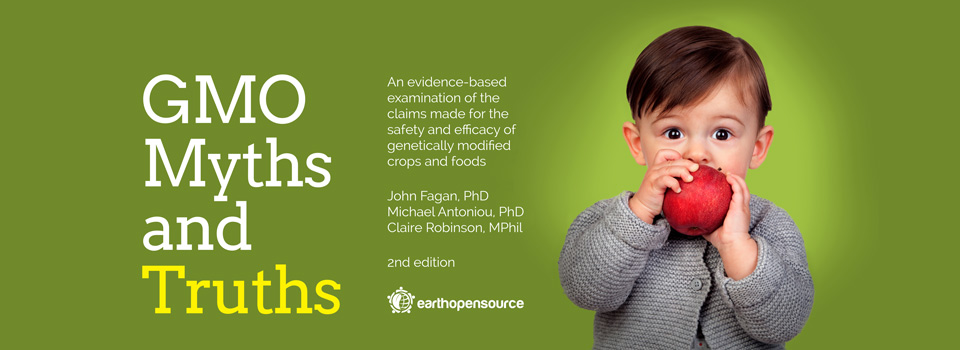 Proponents of genetically engineered / modified (GE/GM, GMO) food often characterize the debate as one of science versus superstition. The implication is that those opposed to GE/GMOs are irrational anti-science cranks or they are misguided by religious ideas. In fact, most of the opposition to the use of GE in agriculture is based on scientists’ informed concerns about long-term environmental hazards and potential health hazards for humans.
Proponents of genetically engineered / modified (GE/GM, GMO) food often characterize the debate as one of science versus superstition. The implication is that those opposed to GE/GMOs are irrational anti-science cranks or they are misguided by religious ideas. In fact, most of the opposition to the use of GE in agriculture is based on scientists’ informed concerns about long-term environmental hazards and potential health hazards for humans.
GMO Myths and Truths, co-authored by genetic engineers Dr. John Fagan and Dr. Micahel Antoniou and researcher Claire Robinson was originally released in 2014, is in its 3rd updated edition (2016). The authors puncture the myths promulgated by the GMO industry, a cartel made up of a handful of giant agrochemical companies led by Monsanto. Their goal is to control the world food supply by suppressing independent scientific investigations and open debate. GMO promoters have perverted science by concealing and suppressing inconvenient scientific findings, and disseminating propaganda to deceive the public.
A major problem is that the field is overrun by scientists under the influence of industry which funds them directly or indirectly. A study has shown that 156 of 168 food studies showed biased results favoring the sponsor’s interests:
“Researchers who take food industry funding do not believe that it affects their study design or interpretation and are outraged at the suggestion. Research, however, shows strong correlations between funding and research outcome.” (“Before You Read Another Health Study, Check Who’s Funding the Research,” The UK Guardian, Dec. 2016)
The biotech business venture is led by the Monsanto, which has radically transformed U.S. agriculture and the food industry to genetically engineered (GE) food products. For most of its history, Monsanto was a giant scandal-ridden chemical company producing some of the most toxic substances ever created. The company’s poisonous chemicals have left communities around the world with deadly environmental consequences.
“Although Monsanto likes to depict biotechnology as just another in an ancient line of human modifications of nature going back to fermentation, in fact genetic engineering overthrows the old rules governing the relationship of nature and culture in a plant. For the first time, breeders can bring qualities from anywhere in nature into the genome of a plant… The introduction into a plant of genes transported not only across species but whole phyla means that the wall of that plant’s essential identity — its irreducible wildness, you might say — has been breached.” (“Playing God in the Garden” Michael Pollan, The New York Times Magazine, 1998)
Millions of acres of land have been planted with genetically altered plants; introducing something novel into the environment and into the food chain. The long-term consequences of this novelty are not completely understood; uncertainty about safety, therefore, continues to be a concern for scientists, environmentalists, and informed lay people. In 1998, scientists raised the issue of “biological pollution” which unlike chemical pollution cannot be cleaned up or dissolved over time; biological pollution is more like a disease which incubates over time before it emerges. (The Biotech Century by Jeremy Rifkin, 1998)
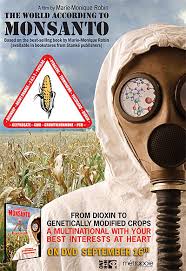 Monsanto morphed from being a scandal-ridden chemical giant into a biotech seed company. The transition to “life sciences” began in 1979 under the guidance of Mitt Romney at Bain & Co., who helped Monsanto shift the company’s strategic research focus to biotech. (“How Mitt Romney Helped Monsanto Take Over the World,” Mother Jones, 2012) Monsanto hired biologist Howard Schneiderman (University of California) as its research director and invested hundreds of millions a year in biotech hormones and GE seeds –i.e, Roundup Ready seeds which are intertwined with Monsanto’s herbicide / pesticide Roundup.
Monsanto morphed from being a scandal-ridden chemical giant into a biotech seed company. The transition to “life sciences” began in 1979 under the guidance of Mitt Romney at Bain & Co., who helped Monsanto shift the company’s strategic research focus to biotech. (“How Mitt Romney Helped Monsanto Take Over the World,” Mother Jones, 2012) Monsanto hired biologist Howard Schneiderman (University of California) as its research director and invested hundreds of millions a year in biotech hormones and GE seeds –i.e, Roundup Ready seeds which are intertwined with Monsanto’s herbicide / pesticide Roundup.
However, Monsanto never abandoned its ruthless corrupt corporate modus aperandi; which includes concealing evidence linking its biotech products to harm. The company was soon embroiled in hundreds of bitter GMO controversies around the world; “trading one set of environmental controversies for another.” (Wayne Barrett, The Nation, 2012)
“GMO agriculture relies on the relatively new science of bioinformatics (a mixture of bio- and information science), which means that DNA sequences look a lot more like software code than a vegetable garden. And if Monsanto is the Microsoft of food supply—raking in the rent on bites instead of bytes—perhaps the time has come for the agricultural equivalent of Linux, the open-source operating system that made computer programming a communal effort.” (“Let’s Make Genetically Modified Food Open-Source,” Slate, 2013)
The New York Times reported that Monsanto’s executives who planned the strategic launch of the new technology, recognized that bioengineering raised concerns about possible allergens, unknown toxins and environmental effects and that there was reasonable philosophical anxiety about human manipulation of nature. (“Redesigning Nature…” 2001) However, Monsanto disregarded scientists’ concerns about potential safety hazards, and declared that GE/GM foods are “substantially equivalent” to naturally grown foods which have a long proven safety record.
This specious claim became the guiding principle of FDA’s 1992 GMO guidelines which exempted GE products from scientific safety studies prior to their marketing. Those FDA guidelines were drawn up by Monsanto’s lawyer, later its Vice President Michael Taylor. The guidelines have not been modified or updated even as mounting evidence – and a federal judicial review – determined that the “substantially equivalent” claim was contradicted by the evidence. (Read more here)
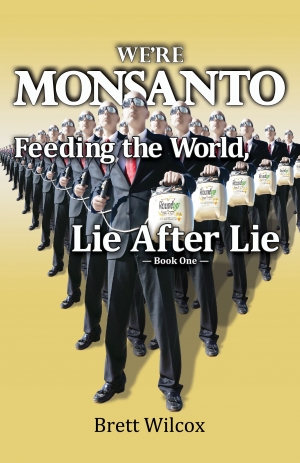 False claims, corrupt science
False claims, corrupt science
Monsanto claims that the safety of its GE products is backed by solid science; but the safety of GE products which are infused with pesticides has never been properly tested because the company circumvented scientific safety tests for its GE products, arguing that safety studies are unnecessary because the proven safety record of naturally grown foods applies equally to GMOs. The FDA exempted GE food from safety testing by endorsing both of Monsanto’s unsubstantiated claims: that GMOs are “substantially equivalent” to naturally grown food; and that GMOs are recognized as safe by an overwhelming consensus among scientists.
Internal FDA documents expose the lies underlying FDA’s official assertions that GE foods are “substantially equivalent” to conventionally produced foods; that their “proven safety is grounded in science;” and that they are “generally recognized as safe.”
The documents were uncovered in 1998 by attorney Steven Druker who initiated a lawsuit against the FDA on behalf of the Alliance for Bio-Integrity and a coalition of nine scientists and twelve religious leaders who were co-plaintiffs.
It was the first time that scientists had sued a federal administrative agency on the grounds that one of its policies is scientifically unsound. The scientists did so at great personal and professional risk; as negative views about biotechnology are not tolerated.
The debacle of Flavr-Savr tomatoes: a case of fraud, deception and subversion of science
The first genetically engineered food to be marketed in the U.S. was the Flavr-Savr tomato produced by Calgene; launched with great media fanfare in May 1994. The Flavr-Savr tomatoes were engineered for longer shelf life. Monsanto bought Calgene, acquiring its GE patents; but the tomatoes proved highly perishable requiring costly packaging or they became mush en route to grocery stores. Monsanto never marketed another GE tomato. (Retro video Report, New York Times, 2013)
 Flavr Savr safety issues revealed in the FDA documents:
Flavr Savr safety issues revealed in the FDA documents:
Although the FDA did not require testing, Calgene voluntarily subjected its two lines of Flavr Savr tomatoes – each having the same gene inserted – to animal feeding studies. Unlike ALL other GMO producers, Calgene scientists were committed to full disclosure; the company submitted detailed data about its feeding study, asked the FDA to review the data; and clearly labeled the GE tomatoes. FDA scientists noted a pattern of stomach lesions (bleeding) that raised a safety issue. Indeed, seven of the 40 rats fed the same Flavr Savr variety as those who developed lesions, died within two weeks. (Jeffrey Smith, The Huffington Post, 2011)
Dr. Robert J. Scheuplein, director of the FDA’s Office of Special Research Skills, wrote: “… the data fall short of ‘a demonstration of safety’ or of a ‘demonstration of reasonable certainty of no harm’ which is the standard we typically apply to food additives.
FDA officials committed fraud. Not only did they completely disregard FDA’s scientists’ safety concerns and approved Flavr Savr tomatoes; they declared that the tomatoes had performed so well that no subsequent bio-engineered food would be subjected to meet those safety standards:
“The agency claimed that all relevant safety issues had been satisfactorily resolved and said that because the Flavr Savr had performed so well, it would be unnecessary for any subsequent bioengineered food to be subjected to the same standard of testing.”
“To date, there is no reliable evidence showing that any has satisfied the standard the Flavr Savr failed to meet.”
However, in 2010, a federal court of appeals overruled FDA’s claim that genetically engineered milk infused with growth hormone was “substantially equivalent” to natural milk. (Read about Monsanto’s Posilac milk debacle here) A lawsuit by the Alliance for Bio-Integrity exposed FDA fraud, providing documents demonstrating ardent dissent rather than consensus among FDA scientists who argued that GE is different and potentially hazardous to human health. In fact, GE foods have been promoted mostly by the propagation of false claims and misrepresentations which are endorsed by authoritative government agencies, and by a network of “indemnified scientists” and scientific institutions.
“If a policy can be claimed to be based on science, it acquires a privileged status. Anyone who disagrees is treated like the crank…governments are anxious that what is accepted as science is in line with what they want to do. They tend to appoint as advisers people who will produce the advice they want to hear.” (“Politically Correct Science for the Masses,” Institute of Science in Society, 2014)
By invoking “science” GMO promoters appealed to college educated American liberals; as these folks tend to embrace anything purporting to be “science” lest they be discredited as “anti-science” quacks – as are those who deny global warming and climate change. Indeed, that specious comparison was promoted in a recent article published in PLOS One (“Cognitive Biases in the Assimilation of Scientific Information on Global Warming and Genetically Modified Food,” 2015). The article equated unsound public opinion about global warming and GMOs. Its authors are two faculty members at land grant colleges (University of Florida, Institute of Food and Agricultural Sciences and Oklahoma State University) The PLOS article was then broadcast to a larger audience by Science Daily (Nov. 2016) insinuating that intelligent people trust science: “People who know about genetically modified food agree with science: they’re safe.”
Monsanto secured the endorsement of a chorus of “upbeat” supportive scientists
Upbeat scientists are the purveyors of good news that supports industry’s objectives; these scientists legitimize public policies that are favorable to industry. Downbeat scientists point out inconvenient truths about risks and uncertainties that industry vigorously denies. Many of the most prominent upbeat GE scientists are employed or partly funded by corporations. Monsanto secured the endorsement of a chorus of “upbeat” supportive scientists – most notably at land grant colleges whose food and agricultural science institutes it endows. Charla Lord, a Monsanto spokeswoman, said the company’s longstanding partnership with academics helped demystify the science: “It is in the public interest for academics to weigh in credibly, not only to consumers but to stakeholders like lawmakers and regulators as well.”
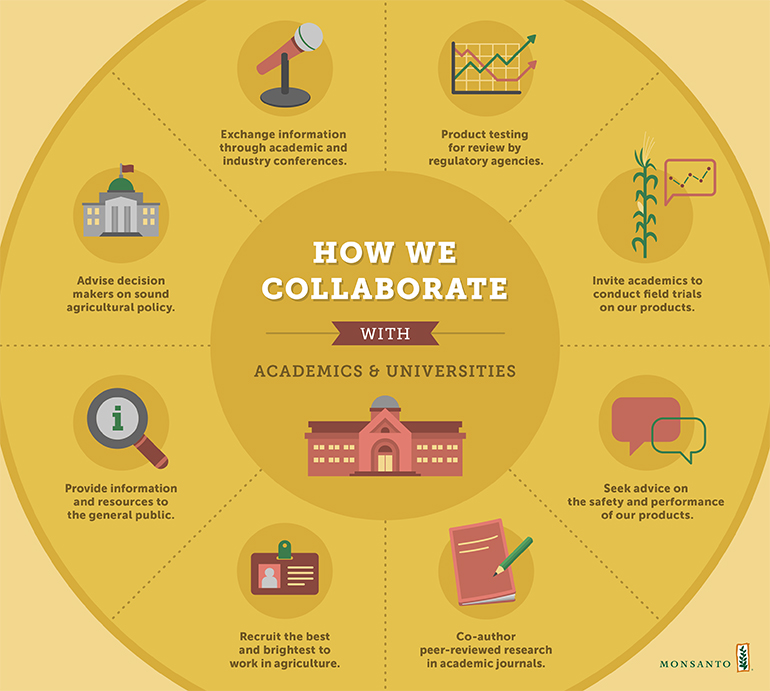
These “indentured scientists” aggressively promote Monsanto’s propaganda, claiming they represent a “consensus of scientific opinion.” They assume the mantle of “experts” and are recognized not only by industry, but also by academic institutions. They are the officers of august professional associations, the editors of premier scientific journal publications, and they are appointed to prestigious government advisory committees. These constitute the influential sources of information that the media cites and relies upon to broadcast an upbeat “science” message to the public.
Evidence contradicts claim of a consensus among scientists Re: the safety of GMOs
In January, 2015, a broad community of independent scientists issued a joint statement signed by 300 scientists, challenging those who make the spurious claim of a “consensus” within the scientific community that GE foods are safe. “No Scientific Consensus on GMO Safety,” was published in the peer-reviewed journal, Environmental Sciences Europe; also posted by International Science in Society)
“…the claimed consensus is shown to be an artificial construct that has been falsely perpetuated through diverse fora. Irrespective of contradictory evidence in the refereed literature, as documented below, the claim that there is now a consensus on the safety of GMOs continues to be widely and often uncritically aired. For decades, the safety of GMOs has been a hotly controversial topic that has been much debated around the world. Published results are contradictory, in part due to the range of different research methods employed, an inadequacy of available procedures, and differences in the analysis and interpretation of data.
Such a lack of consensus on safety is also evidenced by the [2011] agreement of policymakers from over 160 countries – in the UN’s [..] Guidelines of the Codex Alimentarius – to authorize careful case-by-case assessment of each GMO by national authorities to determine whether the particular construct satisfies the national criteria for ‘safe’. Rigorous assessment of GMO safety has been hampered by the lack of funding independent of proprietary interests. Research for the public good has been further constrained by property rights issues, and by denial of access to research material for researchers unwilling to sign contractual agreements with the developers, which confer unacceptable control over publication to the proprietary interests.”
The scientists noted the following:
1. There is no consensus on GM food safety
2. There are no epidemiological studies investigating potential effects of GM food consumption on human health
3. EU research project does not provide reliable evidence of GM food safety
4. A list of several hundred studies does not show GM food safety
5. There is no consensus on the environmental risks of GM crops
6. International agreements show widespread recognition of risks posed by GM foods and crops (“No Scientific Consensus on GMO Safety,” Environmental Sciences Europe, 2015)
Attorney Steven Druker points out:
“[The] advancement and very survival [of the industry] have been crucially and chronically dependent on the misrepresentation of reality—to the extent that more than 30 years after the creation of the first genetically engineered plant, the vast majority of people the world-over (including most government officials, journalists, and even scientists) continue to be misled about the important facts.” (How FDA Deception Promotes Genetically Engineered Food, 2016)
Philanthropic self-interest: Bill and Melinda Gates Foundation promotes GMO propaganda while investing in Monsanto
An illuminating article in Counter Punch (2016) whose author, Patrick Bond, professor of political economy (University of Witwatersand, Johannesburg) had been in Nelson Mandella’ new South African government. He authored more than a dozen policy papers. Prof. Bond reveals that Bill Gates is said to be worth $80 billion today. His wealth accrued through blatant anti-competitive business practices such as bundling Windows with a slow, security flaw-ridden Internet Explorer web-browser — as revealed by US prosecutors. The Gates Foundation evidently practices what has been termed, “philanthropic-capitalism.” The foundation’s pervasive influence in international development renders those who depend on its patronage and funding silenced; unable to express any criticism.

In 2010, the Seattle Times reported that the Gates foundation bought 500,000 shares of Monsanto stock valued at about $27.6 million ($38 million in 2016), and the foundation is partnering with Cargill in a $10 million project to impose GM soya in Mozambique. These investment deals raise serious doubt about the purpose of its purported charitable funding of other multi-million dollar biotech farming projects.
The Gates-supported Alliance for a Green Revolution in Africa (AGRA) lobbied the governments of Ghana, Tanzania, and Malawi among others to adopt pro-GMO policies. Prof. Bond says that Gates’ power threatens African food supply because GMOs benefit the interests of Big Agra corporations, such as Monsanto, but wipe out small local farmers. The Foundation’s CEO’s response to hundreds of Seattle residence who protested: “It would be naive…to think that changing the foundation’s investment policy could stop the human suffering blamed on the practices of companies in which it invests billions of dollars.” (Los Angeles Times, 2007)
“What they’re doing is opening up new markets in Africa for Monsanto to monopolize the seed market.” (Gates Foundation Ties with Monsanto Under Fire” The Seattle Times, 2010)
The UK Guardian noted that there was “genuine concern at governmental and community level that the United State’s model of extensive hi-tech farming is inappropriate for most of Africa and should not be foist on the poorest farmers in the name of “feeding the world”. (2010)
Dr. Phil Bereano, University of Washington Professor Emeritus and recognized expert on genetic engineering: “The Foundation’s direct investment in Monsanto is problematic on two primary levels. First, Monsanto has a history of blatant disregard for the interests and well-being of small farmers around the world, as well as an appalling environmental track record. The strong connections to Monsanto cast serious doubt on the Foundation’s heavy funding of agricultural development in Africa and purported goal of alleviating poverty and hunger among small-scale farmers. Second, this investment represents an enormous conflict of interests.” (Community Alliance for Global Justice, 2010)
“But the most damage done within South Africa was Gates’ promotion of intellectual property (IP) rights. Long-term monopoly patents were granted not only to Gates for his Microsoft software, but for life-saving medicines…
IP became a fatal barrier to millions of HIV+ people who, thanks to Big Pharma’s profiteering, were denied AIDS medicines which cost R150 000/year fifteen years ago. The Gates Foundation was part of the problem by insisting on Merck-branded drugs in its Botswana AIDS clinics” (Read more: Patrick Bond, Counter Punch, 2016)
The Gates Foundation is the largest donor to the Bill, Hillary & Chelsea Clinton Foundation.
The Clinton Foundation promotes industry propaganda, extolling the benefits of biotech farming as a “Seeding Opportunity” in the third World where Monsanto faces fierce opposition — Africa, Malawi, Rwanda, Tanzania. In those countries GMOs are viewed as a proxy for the dangers of an industrialized food system that is dependent on extensive use of pesticides. When she was the U.S Secretary of State, Hillary Clinton vigorously promoted the interest of the GMO industry, Monsanto in particular. Monsanto is a significant donor to the Clinton Foundation.
Reports about Hillary Clinton’s ties to GMO industry giants, and the fact that a Monsanto lobbyist who was actively lobbying to prevent GMO labeling or to tighten regulations for Monsanto’s pesticide Roundup, was Jerry Crawford, Clinton’s senior adviser in her 2016 campaign, and was also part of her 2007 presidential campaign. Crawford “bundled” campaign cash contributions for her 2016 presidential campaign.
It would appear that the mainstream media tends to avoid reporting negative facts about either the GMO industry or about high level officials who support the GMO industry. The revelations uncovered in a cache of emails leaked by Wikileaks about the State Department’s aggressive promotion of GMOs on other countries under both the Bush and Obama administrations, was mostly ignored by the media. Both Hillary Clinton and Condoleezza Rice before her sent out annual memos to all U.S. embassies outlining State Department policy on biotechnology. (Read AHRP post: How Monsanto Rigged the System; Read also Food & Water Watch report Biotech Ambassadors)
In December 2009, Clinton wrote, “Our biotech outreach objectives for 2010 are to increase access to, and markets for, biotech as a means to help address the underlying causes of the food crisis, and to promote agricultural technology’s role in mitigating climate change and increasing biofuel production.”
In 2015, the Washington Times reported about Hillary Clinton’s deep ties to Monsanto and GMOs, noting that: “Mrs. Clinton’s support for Monsanto and genetically modified food was one of the factors that contributed to her embarrassing third-place finish in the 2008 Iowa caucuses.”
“In the GMO debate, Mrs. Clinton has consistently sided with the chemical companies. Her top campaign operative in Iowa is former Monsanto lobbyist Jerry Crawford, who’s also a veteran of Iowa politics and Clinton campaigns. Her history of backing GMO dates back to her early days in Arkansas as a lawyer with the Rose Law Firm, which represented Monsanto and other agribusiness leaders.
Just last year, Mrs. Clinton gave a paid speech at a biotech industry conference in San Diego, where she championed GMOs and advised the executives and investors to give their products an image makeover. “‘Genetically modified’ sounds Frankensteinish. ‘Drought-resistant’ sounds like something you’d want,” she said. “Be more careful so you don’t raise that red flag immediately.”
Big ag also has been a big donor to the Clinton Foundation, the family charity at the center of pay-to-play accusations involving foreign donors while Mrs. Clinton ran the State Department. Monsanto gave the foundation between $501,250 and $1 million. Dow Chemical Company, which is among the top GMO players, gave between $1 million and $5 million, according to financial disclosures by the Clinton Foundation.
Mrs. Clinton’s support for Monsanto and genetically modified food was one of the factors that contributed to her embarrassing third-place finish in the 2008 Iowa caucuses, said Laura Hubka, vice chair of the Tri-County Democrats, a club in Howard, Mitchell and Worth counties along the state’s norther border with Minnesota.
“We are very environmentally active,” said Ms. Hubka. “It would be great to hear her come out and speak against Monsanto and what it has done to our farmers as far as our corn production now. There’s a lot of things Monsanto has done that [have] made us unhappy.” “We are hoping to see her make a turn also against Monsanto. That would be fantastic for us.”
Monsanto’s massive propaganda campaign seduced mainstream media
A prime example of a fawning media is a promotional piece in Fortune (June 2016)
The article is penned by Beth Kowitt; it is titled “Can Monsanto Save the Planet?” The article is accompanied by a video interview with Monsanto’s CEO, Hugh Grant in which the reporter begins with a misrepresentation: “So, we have had three years of record harvests…”
The purpose of the article and video was to humanize the company’s image, highlighting its claimed successes; and to show that Monsanto’s reputation as “the most vilified company” (the phrase is cleverly inserted in its subtitle and within the text) is an unjust assessment by “its diehard critics”. Kowitt writes:
“To its diehard critics [Monsanto] embodies all that is wrong with big, industrial agriculture—the corporatization of farming, the decline of smallholders, the excessive use of chemicals, a lack of transparency, and, of course, the big one: the entry of genetically modified organisms into our food supply. The tri-letter acronym GMO has become a four-letter word to millions of people, from earnest middle-schoolers to purist Whole Foods shoppers.”
The article is a glowing promotional description of Monsanto’s vision for the future; its corporate crimes are glossed over as “the demonizing of the company by critics who profess bizarre conspiracy theories.” The picture painted by the Kowitt is that of a public spirited company whose focus is on solving the monumental problem of feeding the world by overcoming the difficulties posed by climate change. The upbeat promise is that Monsanto “has a plan to feed us all.”
Empirical evidence of GE’s failure to increase crop yields are misrepresented as a success. And the fact that Monsanto’s strategy failed to reduce the use of herbicides; in fact it increased their use significantly, thereby increasing its profits – is not mentioned. Monsanto’s CEO, Hugh Grant, is portrayed as a visionary who looks “beyond seed technology,” (which he obliquely acknowledges, has not turned out to be the hoped for panacea). Grant is described in this puff piece, as a man who favors “big data” to solve the global food problems:
“The company that was founded in 1901 as a chemical maker, then turned itself into a biotech company, and finally became a seed company is metamorphosing anew: this time, into a data company. Explains Grant: ‘Ultimately data science becomes the glue, the catalyst, that holds the chemistry and biology together.’
The company’s new mission: ‘Feeding the world through math.’”
“…Monsanto’s plan to feed us all… through math“… is a chilling thought. It brings to mind a quote attributed to Henry Kissinger who understood the methods of world domination:
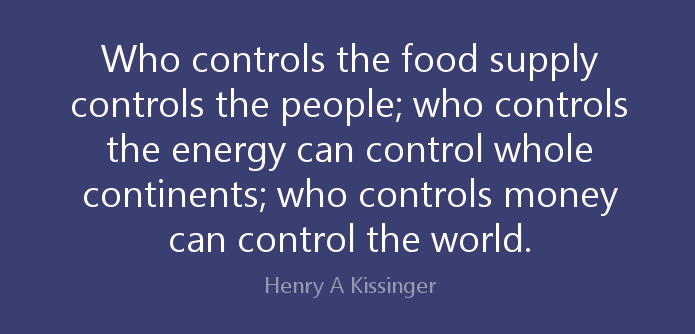
Read AHRP GMO-related posts:
How Monsanto Rigged the System through politics and propaganda;
GMO Crops Have Failed to Lift Yields and Ease Pesticide Use;
How American consumers became de facto guinea pigs;
A GMO Debacle: Growth Hormone Contaminated Milk;
Scientific review of pesticide cancer risk ignites war against scientists
GMO reliance on toxic chemicals spawned a profusion of Super Weeds



